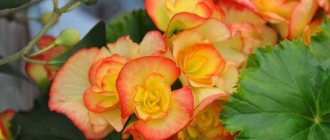History and description
Green roses were bred by the Dutch botanist Mayer. The specialist conducted numerous experiments. In 1782, he grafted a white rose onto a blackthorn shoot. The result was the appearance of a crop with green petals.
The height of the bushes depends on the variety. The shoots are powerful and have thorns. Inflorescences are small, large, medium. The color of the petals varies from a soft light green palette to a dark green color. They can be simple or terry. The buds are formed solitary or in clusters of inflorescences.
Propagation and cuttings
Growing flowers from cuttings is not an easy task for a novice gardener. If you understand the intricacies of this process, then landing will not be difficult.
There are several ways to propagate green roses:
- Seeds. This is the simplest option, in which the seeds are taken from the fruit or bought in a store. To test for germination, they are soaked in hydrogen peroxide for one day. The seeds are placed in the soil and wait until it hatches. This process will take from one and a half to two months. Sowing is recommended in April.
- Vegetative propagation. This method is based on the ability of plants to divide cells. This means that the rose is able to regenerate itself from a stem, root or leaf. There are several methods called layering, cuttings, dividing the bush or grafting.
- Dividing the bush. A part of the plant with roots is separated from the main bush and transplanted to the chosen location. After the planting process, carry out abundant watering and hilling.
- Reproduction by grafting.
Propagation by layering and root suckers is the least suitable for green roses. Experts recommend cuttings. This propagation method increases the plant's chance of survival.
For cuttings, you will need bushes that have grown all season in greenhouse conditions. If last year's shoots are used for planting, then a special storage regime is observed (in peat in a room with low temperatures).
Planting is carried out in the spring. The stem is cut under the lower leaf of the cutting, as well as above the upper bud. A couple of leaves are left on top, which will subsequently perform the function of photosynthesis and allow the root system to develop in the ground.
It is important to remember that the cuttings are strengthened into the ground at a slight slope. This can be planting in a separate bed or using a container filled with a peat mixture.
For planted cuttings, you need a reliable shelter that creates a greenhouse effect. This task can be accomplished by using a plastic bottle placed on top.
It is removed before the first roots appear (they will appear half a month after planting in the ground). After one month, the plant can be dug up and planted in a permanent place for further development.
Planting and caring for a rose is hard work. However, with quality care, the plant can take root and delight with its beauty. There is no need to give up growing this shrub just because it is fussy about care and temperature. Perhaps the bush will grow and bear fruit, which will delight the owner of the house and his family with wonderful flowering and a cut bouquet.
Popular varieties of green roses
Breeders have bred many roses with green petals. The most popular varieties are:
Green Ice
The bushes of the crop reach a height of 40-50 centimeters. Gardeners use low-growing plants as borders. The buds initially have a pink-green color. The petals are shaggy and twisted. At the stage of complete dissolution, the buds acquire a white-green color. In comfortable conditions, the rose blooms three times per season.
Greensleeves
The height of the bushes of this variety varies between 75-85 centimeters. The leaves are dark green, glossy. The buds at the formation stage are light pink in color. Gradually the petals acquire an emerald color. The advantage of the variety is its good resistance to black spot.
Green Tea
The height of the bush is about 90 centimeters. The shape of unopened buds is a glass. Each of them contains 25-30 petals with wavy edges. At the dissolution stage, the bud takes the shape of a deep bowl. The petals are colored light green.
Super Green
The rose of this variety is not tall. Its beauty lies in its double buds. Each flower consists of 50-130 petals. The edges of the buds are painted in a light green palette.
The middle of the flower takes on a rich color. Florists love to use Super Green for bouquets.
Limbo
The bushes of the variety are compact: the height does not exceed 80 centimeters. The leaves are large and glossy. The resulting buds are cone-shaped. When fully bloomed, the flower takes on the appearance of a bowl. The petals are painted with a yellow-green palette.
See also
Description and rules for growing floribunda roses of the Kimono varietyRead
Wimbeldon
The bushes, about 1 meter high, have sparse thorns. Petals are yellow-green, wavy. The unusual thing about this variety is that there is a red stripe along the edges of the buds. The flower is loved by florists: they create beautiful compositions from the plant.
Lime Sublime
The rose variety was bred by Irish specialists. The bushes bloom profusely and for a long time. The first buds appear in late spring. Flowering lasts with a short break until the beginning of autumn. The petals are painted with a soft green palette. Lime tolerates the scorching sun well.
St. Patrick's Day
This rose variety is intended for cultivation in the southern regions, as it does not tolerate cold weather. The bud of the hybrid has a goblet shape. At the dissolution stage, the inflorescence becomes cup-shaped and reaches 12 centimeters in diameter. The petals are painted with a golden-green palette.
Gloria Dei
The main color of Gloria Day's buds is pink-yellow. The petals of the variety have only small inclusions of green color. The diameter of the inflorescences is 13-15 centimeters. The bud contains 45-50 petals. Gloria Day is the progenitor of many rose hybrids.
David Austin roses – professionals advise...
About new products...
Gracefully folded petals, pastel colors, nostalgic flower shape, maddening aroma, abundant re-blooming - this is why Russian rose growers have always loved David Austin roses.
And his latest new products have one more undoubted advantage - healthy foliage. Let's put the fungicide sprayer aside and admire these varieties, beautiful in all respects! Elegant elongated apricot-yellow buds of the climbing rose 'Bathsheba' open into densely double flowers in the shape of shallow cups about 10 cm in diameter.
The petals are tightly gathered into exquisite rosettes: the front side of each is painted in a rich apricot tone with a barely noticeable pink tint, and the back side is yellow. This play of color, coupled with the frame of lighter, creamier outer petals, makes the flower appear to glow from within. The rose exudes the scent of myrrh, floral and warm, with a hint of honey.
And from a mature flower you can smell the light aroma of a tea rose.
Rose Imogen is distinguished by its profuse flowering, but it is also interesting to watch it when it is still in buds. Narrow, with a pointed apex, before opening they sharply “gain weight” and become more rounded. Light lemon-yellow petals are collected in classic double rosettes with a button, medium-sized flowers. Over time, they fade to a creamy shade, turning into charming “dishevels”. The aroma is light, fresh, with apple notes. The bush is powerful and erect. The name of the variety was given by the heroine of one of Shakespeare's plays.
Another tribute to the work of the famous English poet and playwright is the long-blooming rose Desdemona - the owner of peach-pink buds and pure white cupped flowers (at the beginning of dissolution they have a barely noticeable pink blush). Over time, they open a little more - so that among the delicate satin of the petals you can see the stamens. The flowers, emitting the scent of myrrh, hold their shape even in rainy weather. A powerful, loose and wide bush will fit into both a traditional rose garden and a mixborder with perennials.
Variety Roald Dahl. David Austin dedicated the centenary of the birth of the famous English writer and screenwriter Roald Dahl.
The reddish-orange, ripe peach-colored buds open into cup-shaped rosettes of medium size and a lighter, apricot tone. The bush blooms almost continuously, and the flowers, despite their elegance, withstand inclement weather. The light, enchanting aroma of tea rose is mixed with fruity notes. The bush is round and branched, and the small number of thorns makes caring for the sensual beauty extremely pleasant.
From the beginning of summer until frost, the rose The Ancient Mariner, without the slightest hint of a break, delights with abundant flowering. The petals of very large, cup-shaped, densely double pink flowers are elegantly curved towards the center. The aroma is intense, warm, myrrh. A fully bloomed flower shows the stamens, and the color of the petals changes from deep pink in the center to light at the edges. The bush will be good in the middle or background of flower beds and in solitaire planting.
The Poet's Wife is a gorgeous rose with deep yellow flowers. If they fade, it is not to a whitish color, like other yellow “osts”. Their shape is mesmerizingly beautiful: a ring of neatly folded outer petals frames the inner petals, which are less strictly arranged.
The bush is low and naturally round in shape (it grows wider rather than higher), so it is ideal for the foreground of flower beds. The rose has a bright, rich aroma: at first, lemon notes stand out, but as the flower ages, it becomes sweeter and stronger. David Austin dedicated this variety to his wife. And, if you didn’t know, yes, this famous rose grower writes poetry!
Olivia Rose Austin is named after David Osty Jr.'s daughter, so this is a really special rose. According to David Austin Sr., this may even be the best rose of his selection presented to date.
This beauty has flowers of an ancient shape: goblet-shaped buds gradually open into small cup-shaped rosettes up to 9 cm in diameter. They are good at all stages of dissolution. The color is a charming soft shade of pink. The scent of rose is divine: it has a strong aroma with distinct fruity notes. Grows vigorously and reblooms well.
Specifics of cultivation and care
The decorative effect of green roses depends on planting in the right place and on timely implementation of agrotechnical measures. Purchase seedlings from plant nurseries or garden centers. There should be no dents, stains or damaged parts on the bushes. 1-2 hours before planting, the plants are placed in water, to which potassium permanganate can be added for disinfection.
Landing
Roses are planted in the ground in spring or autumn. Choose a sunny place, protected from cold winds. The culture does not tolerate lowlands and wet areas. The substrate for plants is made up of garden soil, compost, peat, sand. The hole is dug 2 weeks before planting the bushes in open ground.
Planting a green rose is done as follows:
- dig a hole 50 centimeters deep and wide;
- 10-15 centimeters are filled with drainage made of fine crushed stone, expanded clay;
- pour the fertile layer mixed with a small amount of mineral fertilizers;
- pour out the rest of the substrate in a heap;
- Place a bush in the middle, straighten the roots;
- covered with substrate.
The bush is watered abundantly and mulched.
Specifics of care
Caring for roses involves watering, fertilizing, loosening the soil, and mulching. Faded buds are cut off. This is necessary for the formation of new inflorescences, as well as for maintaining the decorative appearance of the bushes. To prevent the occurrence of diseases, plants are sprayed with fungicides in the spring.
See also
Varieties and selection of the best supports for climbing roses, how to create them yourselfRead
Watering
The tree trunk circle is irrigated after the top layer of soil has dried. Excess moisture can lead to the appearance of putrefactive microorganisms. Water the rose in the morning or evening with warm, settled water. At least 1 bucket of water is poured under the bush.
Loosening and mulching
A few days after watering, the soil around the bushes is loosened. The procedure promotes air access to the root system. Weeding removes weeds that carry diseases and pests. To preserve moisture, the tree trunk circle is sprinkled with mulch consisting of sawdust, straw, and peat.
Top dressing
For rapid growth of shoots, abundant and long flowering, green roses are fed several times a season. In the spring, nitrogen is used, in the summer - mineral fertilizers with an advantage in the composition of potassium and phosphorus. In the fall, potassium is added, which contributes to the successful wintering of the bushes.
Trimming
Dry, broken, diseased stems are cut off throughout the season. Remove shoots growing inward. The buds that begin to dry out with parts of the branches are cut off. After this, the bushes not only look more decorative, but also begin to grow young shoots from the lateral buds.
How to plant a green rose correctly
Many gardeners wonder when is the best time to plant such an unusual crop. It all depends on in which region of the country it is planned to grow one or another variety. In the central part, the last days of spring or the first days of summer are usually chosen for planting. If the climate is hot enough, then it is better to plant in the autumn. This way you will protect your roses from hot weather and excess sunlight.
Green rose is not an easy crop to care for. Not every gardener manages to successfully grow it on their site. But if the vagaries of a beautiful plant do not frighten you, then remember certain rules and procedures related to agricultural technology.
1) First, select good planting material. It is best to choose large stores, reliable nurseries and specialized garden stores for these purposes. You should not take seedlings from dubious private owners. When choosing seedlings, pay more attention to those plants whose rhizomes are most developed and do not have mechanical damage.
2) As a rule, planting is carried out in spring. This will give you a better chance that your seedlings will take root in their new location. If the climate is hot, organize planting a green rose in the fall. If you plan to plant your green roses in the summer, then there is a risk that the aggressive rays of the sun will harm your young bushes.
3) Gardeners most often use two methods for planting roses. In the case of the first, planting holes are prepared in advance, the plant is planted in them and thoroughly watered. Method number two is a little more difficult. Roses are planted in special containers. The container should be of such a size that the plant's root system does not feel cramped. It is necessary to fertilize; for this, gardeners use compost. You can also fertilize the soil with mineral fertilizers. In this case, you need to plant roses in the same way as in the first option. The pit is prepared in advance, a container with seedlings is placed in it, and then filled with soil. After this, the plants need to be watered thoroughly.
Diseases and pests
The appearance of diseases and pests on roses is facilitated by: unfavorable weather conditions, dense plantings, damage, and poor care. The presence of weeds increases the risk of attacks on plants by pathogenic microorganisms and harmful insects. Green roses can be affected by powdery mildew. The disease is favored by a humid environment. It is manifested by the presence of a powdery coating on the leaves and shoots. Another common crop disease is rust. The fungus causes yellow-orange bumps to form on the leaves.
The main pest of roses is aphids. It densely adheres to the shoot with the bud rudiment and drinks the cell sap. Another pest, the spider mite, is found on the underside of the leaves. Under unfavorable influence they turn yellow and fall off.
Note! To prevent the appearance of diseases and pests, bushes are treated with special preparations several times a season.
About green rose pests
Often, when the leaves and flowers develop, the bushes are attacked by various harmful insects. They destroy the inflorescences and also spoil the entire decorative appearance of the green rose. We list the most common pests that are dangerous to green roses.
1) Roseate sawfly (caterpillar). It sucks out plant debris from the foliage of the plant, thereby disrupting the metabolism of your rose.
2) Ants and rose aphids. These are insects walking side by side. If you see an anthill near the pink plantings, get rid of it immediately. Ants are carriers of aphids.
3) Drooling pennies. This pest spreads foam that is poisonous to plants and also deprives your bushes of plant sap. As a rule, pennies are located on the lower part of the foliage.
4) Leaf rollers. When plant shoots begin to ripen, they are right there. They also sometimes appear in the summer.
All these pests can be dealt with in different ways. For example, leaf rollers are collected by hand. The slobbering penny too. Aphids and ants are destroyed or driven away using insecticides or traditional methods. Caterpillars are also collected by hand or destroyed using pesticides.
Combination with other plants
To maximize the advantages of green roses, they need to create the right frame. Bright plants are planted next to the bushes whose buds are dark green: tulips, verbena, snapdragons, and monarda. The beauty of soft light green inflorescences is emphasized by lavender, sage, and plants with bright pink buds. Gardeners do not recommend planting green roses next to gladioli and dahlias. Cultures have a depressing effect on each other.
Green gladiolus "Dubravushka" and "Australia"
Gladioli with green flowers are still exotic in our garden plots. They are rarely used in landscape design, although the plants are gaining popularity. Connoisseurs have already appreciated them for their pleasant coloring and calming effect on people. They give a mood of calm and peace. The color green represents spring hope and renewal. In addition, flowers can be used to create harmonious compositions in bouquets.
Gladiolus “Dubravushka” has a light green color, a more richly colored lower petal, and has a so-called corrugation with deep folds and pinches. Gladiolus has a strong ear. Growth qualities are excellent. Resistant to high air temperatures.
Gladiolus "Dubravushka" has a slight yellowish tint
Gladiolus "Australia" has a classic styling. Flowers are firmly attached to the stem. This type of gladiolus blooms very early with ten ruffled flowers that open almost simultaneously.
Using the Limbo rose in landscape design
This variety of rose has a very unusual color of buds, so it is not easy to find neighbors for it in a flower bed or flower garden. Rose Limbo is not recommended to be planted in single plantings, since the plant is small, and the flowers may not be noticed from a distance due to their unusual coloring.
Experts advise planting the rose variety William Shakespeare 2000 next to these roses. You can also plant coniferous perennials nearby, the color of whose needles is dark. It is recommended to plant the Limbo rose next to other roses, clematis, lavender or irises, the colors of which range from lilac to blue.
Description of rose flower
This plant is a shrub with rigid stems or green shoots ranging in height from twenty centimeters to six meters. The shoots of the plant have thorns of various sizes and shapes. However, there are varieties that have no thorns at all. The leaves of the plant are complex, consisting of five to eight small leaves. The color of the leaves can range from light green to dark burgundy. Roses are propagated by cuttings or by dividing the bush.
This plant blooms several times throughout the summer. Plant varieties differ in the shape of the bush and the color of the flowers. There are one or several flowers on one shoot. Flowers have different numbers of petals. Simple buds can have from five petals, and densely double ones - up to one hundred and thirty.
There are several groups based on the number of petals:
- Simple roses have a maximum of seven petals per flower;
- Semi-double. They have from eight to twenty petals;
- Terry. They have more than twenty petals;
- Full-double. They have more than sixty petals.
The sizes of the buds of this flower are very diverse and this is very surprising, because the buds of the smallest rose of the “C” variety are no larger than a grain of rice, and the largest bud is about eighteen centimeters.
History of origin of the variety
This rose variety was bred as a cut variety.
Rose Limbo was bred by the famous German breeder Wilhelm Cortes in the last years of the last century.
For many decades, breeders around the world have developed various varieties of roses with petals of almost any color, but they have not been able to develop roses with black or green petals. However, Wilhelm Cortes managed to select the “queen of flowers” variety with the color of the buds closest to green - this was the Limbo variety.
Hybrid tea white roses
Shallots: features of its cultivation and varietal diversity
White roses stand out not only for their excellent color, but also because they combine perfectly with any other colors of roses. They will decorate any bouquet and fit harmoniously into a wide variety of landscapes and site designs. So the demand for varietal white roses is always high. White rose varieties are divided into several varieties based on growth type. The best hybrid teas are presented below.
Photo of hybrid tea white rose variety Virgo (Virgo)
"Virgo" is an interesting variety of roses. The bushes are vigorous, with a large number of branches. The pagons are straight and long. The buds are semi-double, large, up to 10 cm, snow-white, beautifully shaped. The aroma is moderate and pleasant. It is often grown for cutting.
Photo of hybrid tea white rose variety White Christmas (White Christmas)
Photo of hybrid tea white rose variety Snegurochka
Photo of hybrid tea white rose variety Pascali
"Pascali" is a Belgian variety of white roses. Easy to care for, resistant to frost. Several years ago he received the distinction as “The Most Beautiful in the World.” The branches are straight, strong, 170-180 cm high. The leaves are fresh, green. The flowers open slowly, very effectively. Initially they are more cream than white, but when opened they become snow-white.
Photo of hybrid tea white rose variety Winchester Cathedral
This also includes such beautiful varieties as: “Metropolitan”, “Kaiserin Augusta Victoria”, “Mount Shasta”, “Mrs. Herbert Stevens”, “White Swan”.
We create optimal conditions for indoor roses
The indoor rose is a plant of the tropics. Beautiful long-lasting flowering of the queen of flowers at home is achievable. But for this it is necessary to provide the flower with optimal conditions.
- Lots of light. The best window sills for indoor roses are on south, southwest and southeast windows.
- Air humidity and moderate regular watering. Especially during the flowering period. In summer, warm shower 1-2 times a week.
- Sufficient space.
- Optimal temperature. In summer it is moderate, in winter it is cool. Although the rose is an indoor rose, it also needs wintering.
- Disease prevention and regular inspection for pests.
- Weekly feeding with complex fertilizers for flowering plants.
- The soil is light, breathable, nutritious.
- Autumn pruning for 5 buds.
- Wintering in a cool room at a temperature of 6-8 degrees. Watering is rare and not abundant.
You will find even more tips in the article Growing roses in pots - the subtleties of indoor floriculture. If you follow all the rules of care, then already in March the indoor rose will open its first buds and will continue to bloom until mid-autumn. In summer, it is best to place pots with indoor roses on open terraces and loggias, but away from direct sunlight and drafts.
Insecticides for green rose aphids on roses
Advanced stages are difficult to prevent using traditional methods. Large colonies can often be eliminated only through the use of chemicals. Insecticides are used against rose aphids, as well as against other insects. The most common means are the following:
- Karbofos,
- Rogor,
- Aktellik,
- Fufan,
- Arrivo.
Chemical products are toxic and harmful to the environment, plants and animals. They must be used according to the instructions. Insects develop immunity to certain drugs that are used on one plant for a long time.
It is necessary to change the preparations to completely get rid of pests. Among the biological agents you can use Fitoverm, Aversectim and Agravertin.
Agricultural technology for growing roses
Variety of species
Among the variety of forms for a rosary, multi-flowered, hybrid tea and climbing plant forms are chosen. Experienced gardeners can find dwarf, ground cover and erect tall varieties of roses.
In order to enjoy the flowering of this “queen” in your garden for as long as possible, it is recommended to know all its strengths and weaknesses:
- Hybrid forms are distinguished by a high degree of frost resistance, but it is better to cover young plants for the winter.
- In order for rose bushes to grow and develop well, it is necessary to carry out pruning, shaping, and sanitary pruning every year. Autumn pruning of secondary flowering plants is mandatory.
- Planting a crop is equally presentable, both as an independent plant and in group plantings. Roses look especially beautiful when decorating hedges and alpine slides.
- Not only proper planting and choice of variety ensure long-term flowering of the bush, it is also necessary to properly care for it.
Climbing roses: description of the 20 best varieties, planting and care, propagation, pruning | (75 Photos & Videos) + Reviews
Benefits of planting roses in autumn
Therefore, planting roses in winter is ahead of spring planting:
- Humidity is much higher in autumn than in spring, so plants have better roots.
- The land was lost after the summer.
- There is more rainfall in the fall, reducing the need for irrigation.
Gardeners' opinions on planting autumn roses are divided into two halves: Some believe that the bush will not have time to take root and freeze, while others see no other time for planting except autumn. If the procedure is performed correctly, then next summer the garden will delight its owners with a magnificent view of blooming roses and a captivating aroma.
Roses of unusual colors
Spring primroses: names, photos and descriptions (catalog)
Blue, purple, black and green roses appeared on the shelves of flower shops relatively recently. Such flowers do not occur in nature and are created artificially.
Roses of blue, cyan and violet colors emphasize the unusualness and uniqueness of the person to whom they are presented. In art, flowers with blue petals become symbols of an unattainable ideal towards which the author or hero of a work strives.
This implies another meaning of a bouquet of blue roses: the giver, as it were, emphasizes the inaccessibility and mystery of his love.
A green rose speaks of financial well-being and success. A bouquet of green flowers shows their generosity. It is better to give them to successful people who can appreciate and correctly interpret an unusual choice.
Green roses are presented to lovers with the desire to express jealousy or secret dissatisfaction. If the recipient has a passion for unusual things, you can opt for light green flowers.
Black roses are associated with sad events, often even death. Having received them as a gift, you should not think about the bad: black flowers are also intended to symbolize bold endeavors, trips, and ideas.
Black roses meaning. They are presented to express their admiration for the strong spirit and even rebellion of the person to whom they are addressed. It is not recommended to talk about your love and tender feelings using bouquets of a similar shade.
Each shade of rose has its own meaning to consider. Before you go shopping for a bouquet, you should think carefully about what you are going to express with your gift.
It is advisable to give flowers, attaching a note to them, or explain it orally: this will help the recipient correctly understand the meaning of the color of the roses and appreciate the gift.
Video instructions for propagating roses from cuttings
How are green roses doing in the garden?
You can surprise anyone with a bouquet of green roses (for a lot of money), and it’s much easier than growing them yourself. But among the admirers of the royal flower there are those who dream of admiring it every day.
First of all, you need to find a good nursery whose reputation is beyond doubt. After all, you need a rare, unique seedling, and even adapted to the area in which you live.
Be careful when searching for planting material online. Believing 100% that they will send you what you need is imprudent.
The seedling, even from the photo, should look “alive”, strong and without any signs of disease.
How to care for green roses
When caring for roses with green flowers, you need to take into account that they are capricious. Accordingly, proper care is given for “capricious” varieties.
- Watering is regular and plentiful, but infrequent.
- It is necessary to fertilize every two weeks.
- Weed the soil to remove weeds and loosen it. It's better to mulch.
- In order not to miss the disease, you need to inspect the plant more often. Trim the bush for sanitary purposes if pests appear on it.
What does the green color of roses mean?
Florists have only recently begun to use green roses in bouquets. But now we know that green symbolizes fertility.
Such extraordinary roses will be appreciated by cheerful, successful and prosperous people. Even if they do not become an expression of love, the wish for future prosperity will be expressed without words.
How green roses combine with other plants
The following varieties of green roses will look good in a flowerbed:
- sage;
- bells;
- digitalis.
In a word, any flowering annual. The green-flowered rose looks beautiful against the background of bulbous ryegrass.
You should not offer gladioli and dahlias as girlfriends, which will have a depressing effect on the queen of flowers. In the retinue of the green-eyed beauty, select lobelia, cineraria and heuchera.
Landscape design
By inviting the best varieties of green roses into your garden or flower garden, you will begin to admire the richness of shades that its petals are capable of. This is a real landscaping treasure that can be used fantastically in a variety of styles.
For example, the rose “Green Ice” has already been appreciated by experts. The compact flower is planted along the edges of slopes, on the front of the border, and frame paths in the garden.
Adviсe
- To re-bloom a green-flowered rose, pick off faded flowers in time.
- Plant carnations and violas, red perennial berries, and border plants in its surroundings.
We think that you have met the green rose and let it delight you with greenish-yellow, lemon, white-green, and light green flowers. By the way: so far not a single breeder has developed a variety of truly green roses. But there is still more to come. The best varieties of green roses will multiply, showing the world their unusual beauty.
Choosing and preparing a place for planting with your own hands
In order for a flowerbed to please with its decorative properties, it is worth choosing the right place for it. It must meet the following criteria:
- sufficient lighting;
- lack of wind;
- fertile soil.
Roses are not recommended to be planted in low or too wet places. Also, overly shady areas are not suitable for plants.
At the wall of the house
This arrangement helps protect the plants from wind and frost. In order for plants to develop normally, it is necessary to maintain an interval of 50-60 centimeters between them and the structure.
At the fence
Such hedges have excellent decorative properties. At the same time, you should make sure that the plants are not in the shade. It is recommended to plant them 50 centimeters from the structure.
Along the edges of the garden path
This landing option looks very impressive. At the same time, it is possible to provide plants with favorable conditions for development.










